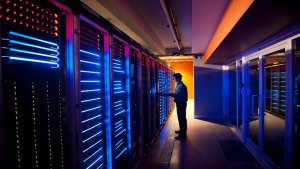 In the post-pandemic world, governments and the business community need to rapidly adjust to crisis-driven transformation, writes Ray Boisvert.
In the post-pandemic world, governments and the business community need to rapidly adjust to crisis-driven transformation, writes Ray Boisvert.
By Ray Boisvert, April 30, 2020.
In the past decade, the world subtly yet effectively emerged into the age of technology enablement. Robotics, mobile devices, Cloud capability, high-speed connectivity and artificial intelligence, all seamlessly underpin a lot of what we do.
In the first wave, it was noticed on factory floors and at the large enterprise level. Later, and closer to home, it has been through our mobile phones, “chatbots” or digital assistants, and other “Internet of things” (IoT) empowered home appliances and work devices. In 2020, almost all services are a click away.
As we face the first full pandemic of the 21st century, the challenges would be far greater if not for these innovations of the past decade. However, as we find new social and economic rhythms in this COVID-19 era, we would be well served to consider how technology is accelerating that crisis-driven and irreversible transformation of our societies.
In one likely prescient example from Beijing’s Tsinghua University, we know that “smart technology” will be a central element in redesigning our future environments. As recently reported, a Chinese designed robot is taking on some of the most dangerous tasks that are currently conducted by physicians, nurses and other front-line healthcare staff, from recording a patient’s vital signs to automated self-sterilization.
As we can imagine, this will likely reshape the work of a group of people who are a critical resource at high risk. And yet that is only the beginning. This particular advancement, among many others taking hold during this crisis, are important examples of how technology will hasten irreversible change in our work and home environments.
Innovation has been unleashed at a global scale. And with that, technology has enabled unprecedented collaboration. Positive stories abound involving the retooling of old and new technology and industrial firms to meet fresh demand for sanitizers, ventilators and personal protective equipment. A very large number of established businesses around the globe have also admirably pivoted by adopting potent levels of “ad-hockery” to ensure the operational viability of commerce, essential services and an increasingly ubiquitous remote workforce.
In simple terms, what has been done will not be easily undone. It also underlines that in transformative times some technologies will be more critical than others – now and later. However, we need to remember that revolution delivers pronounced risk. Reports of global threat actors leveraging the crisis commensurately to the deepening of human suffering is simply evidence of the lesser angels of our nature. What has never been altered in revolutionary times is the benefit of recognizing and understanding malicious intent, and the need to develop a roadmap to effectively and securely exploit emerging opportunity.
In our post-crisis Canada, remote work, schooling, social engagement, business and financial transactions, along with growing e-commerce platforms, will need to be ever more agile and progressively secure. More specifically, as remote work becomes increasingly prevalent, networks will no longer be effectively served by one data storage model, nor best defended by traditional cyber security constructs. And we have yet to fully factor in the important accelerant that is underway in 5G mobile networks.
Organizations, be they commercial or governmental, will require structures that have security embedded at the core of their software, data infrastructure and devices. Agencies and private firms will require new system architectures and philosophical underpinnings. This will include embracing the agility offered through Cloud environments, the force-multiplying effects of cognitive or artificial intelligence, and the protective layering offered by more secure “Zero Trust” environments, in which identity verification is required for network access.
In our new world, governments and the business community, from local to national, need to rapidly adjust to this crisis-driven transformation. Lack of vision or complacency will result in lost relevance and decreased market share. For now, Canadians trust private and public sectors leaders to shepherd our health, social and economic interests through this current challenge. They expect, however, equal assiduity on the issue of our future economy.
Context notwithstanding, and as attributed to Charles Darwin twenty years after the 1837 financial crisis, “it is not the strongest of the species that survives, nor the most intelligent… it is the one that is most adaptable to change.” Leaders that are currently thinking about what that adaptation model looks like will likely succeed. Those that are focused on the key technology that will drive our recovery and future economy are already best positioned to survive and thrive in the decade ahead.
Ray Boisvert is Associate Partner (AP) – Security at IBM Canada. He is a former assistant director of the intelligence directorate of the Canadian Security Intelligence Service.




